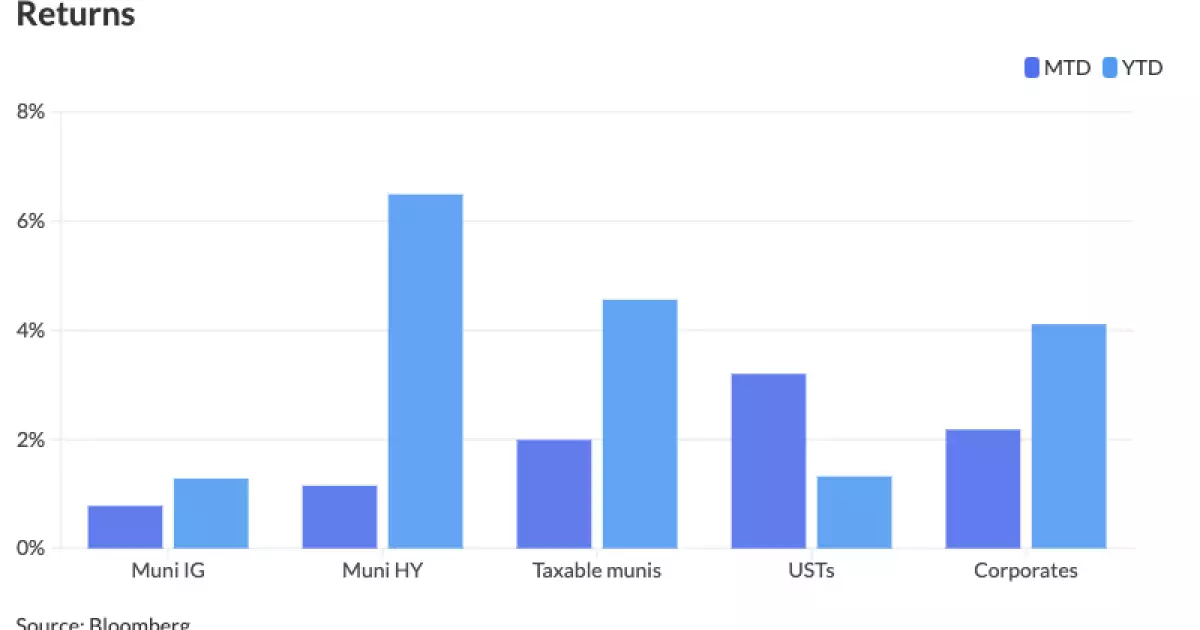The landscape of the municipal bond market continues to evolve, with recent trends showing both stability and fluctuations influenced by external economic conditions. A closer look at the data reveals a consistent performance within the municipal sector, juxtaposed against a backdrop of slight weaknesses observed in U.S. Treasury yields and mixed equity market reactions.
On recent trading days, municipal bonds have displayed remarkable steadiness. As of Monday, U.S. Treasuries weakened slightly while equity markets displayed mixed results; however, the municipal market remained relatively unfazed. According to Refinitiv Municipal Market Data, the ratios of municipal bonds to Treasuries varied across different maturities, demonstrating a strong correlation between these instruments. Notably, the two-year ratios reached 62%, suggesting that investors are favoring municipal securities at this shorter end of the yield curve.
Comparatively, the five-year and ten-year ratios were at 66% and 71%, respectively, indicating that yield spreads between these bonds are narrowing. In essence, this reveals a healthy investment appetite for municipal securities, even amidst broader market fluctuations. The data from ICE Data Services reflects similar patterns, suggesting consensus in market dynamics.
The landscape for municipal bonds this August has been strikingly different from last year’s performance. This month, the municipal sector has recorded an impressive gain of 0.78%, a stark contrast to the 1.79% loss observed in August of the previous year. This shift is pivotal, particularly as the Federal Reserve’s aggressive rate hikes last year aimed to combat soaring inflation.
A significant rise in muni yields in August 2023—averaging 26 basis points across the yield curve—correlates strongly with the Fed’s actions and public statements regarding interest rate adjustments. According to Jason Wong from AmeriVet Securities, the shift in monetary policy articulated by Fed Chair Jerome Powell is anticipated to usher in lower muni yields, a scenario that investors are eager to take advantage of following the drop in Treasury yields.
The “summer slowdown” observed over recent weeks is attributed to seasonal factors, including holidays and absences, contributing to lower trading activity and overall market restraint. Chris Brigati from SWBC noted that the municipal market showed less reactivity to movements within the U.S. Treasury securities market. Nonetheless, following Powell’s recent speech, there was a slight uptick in engagement, particularly in the secondary market for longer-dated bonds, as investors began to position themselves for potential yield declines.
Interestingly, the interest in newly issued bonds remains robust despite the relative lull. Reports from Birch Creek strategists illustrate that separately managed accounts have initiated a positive trend, driving the short end of the municipal curve down by 12-13 basis points. This activity reflects a market that remains speculative yet calculated in its movements, responding aptly to ongoing fiscal policy changes.
Anticipated Issuances and Future Market Outlook
As we advance into the next weeks leading into the Labor Day holiday, expectations for municipal bond issuances remain steady. Analysts note that approximately $8.9 billion worth of municipal bond issues is set to be released this week, which is regarded as relatively average for this period. This includes various high-profile deals such as California general obligation bonds and refunding bonds from San Antonio.
With the market’s eye on upcoming sizeable issuances—ranging from the North Texas Tollway Authority to significant bonds from New York City—it seems the appetite for quality municipal debt is strong. Such strategic moves will likely influence prevailing market trends and could lead to further stabilization or potential growth in returns as new revenues circulate through the market.
The municipal bond market appears to be navigating through a complex set of conditions characterized by macroeconomic shifts and policy changes. While recent trends in Treasury yields may suggest broader market uncertainties, the stability observed in municipal bonds offers a compelling investment narrative.
With various forthcoming bond issuances and anticipated shifts in yields stemming from the Federal Reserve’s decisions, investors must remain alert and adaptable. As the municipal sector stands poised for new developments, the focus on both historical performance and forward-looking indicators will be crucial in shaping investment strategies in the dynamic world of municipal finance.


Leave a Reply